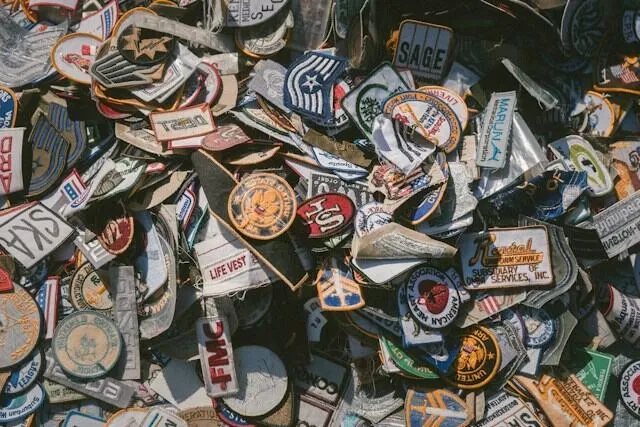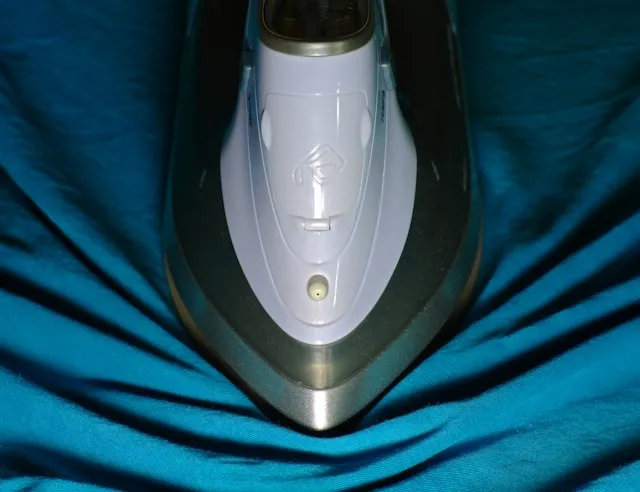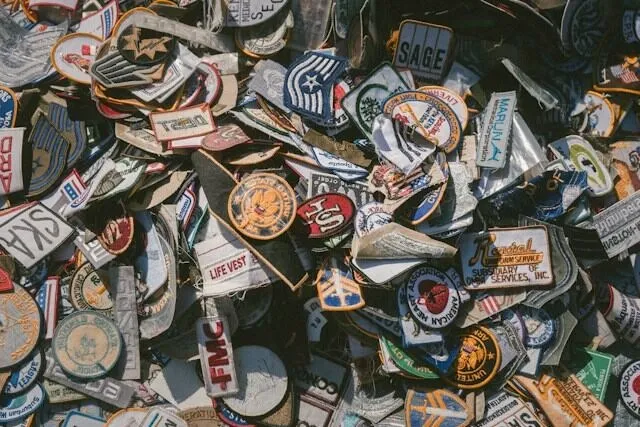How to Iron on a Patch Without an Iron: Innovative Solutions and Techniques
Discover makeshift solutions to apply iron-on patches with no iron in our latest blog post. Whether you’re on the move or simply don’t have a suitable iron for the job, we share some creative ideas to securely put on patches without an iron.
Suggestions include using hair straighteners or finding other heat sources; this guide helps you tap into your resourcefulness to ensure a reliable adherence for your patches. Read on to delve into these unconventional yet effective solutions so you can still get the most out of your patches. This is how to do iron-on patches without an iron.

Key Takeaways
- The most common alternatives to using an iron to attach a patch include hair straighteners, hairdryers, and flat irons.
- The process is similar to using an iron, but you may need to employ additional safety measures to protect your fabric and yourself.
- Patches made from transfer paper may be easier to work with, or you could try sew-on patches instead.
- We supply high-quality custom iron-on patches at competitive prices and can also provide various other attachment methods for your needs.
Table of contents
How to Iron on a Patch Without an Iron: Step By Step
In a situation where you need to iron on patches without an iron, mastering some alternative methods to get a secure patch adhesion is essential. Our custom iron-on patches simply require heat to activate the adhesive, and an iron is the simplest solution. But, when one is not available, other options include:
- Hair straighteners
- Clothing steamers
- Hairdryers
- Flat irons
Here’s a general guide to iron-on a patch without an iron, using an alternative heat source instead.

Clean The Surface Where The Iron-On Patch Will Be Applied
It is important to make sure that the section of fabric where you are attaching the patch is clean. Things like dust and debris can compromise the adhesions, so clear them away before attaching.
Position The Iron-On Patch
Place the patch in the spot where you want it to go with the adhesive side down. Check for proper alignment.
Use A Protective Barrier When You Iron On A Patch With No Iron
Chances are you will have very little control over the heat when you put on iron-on patches without an iron. This means it is important to place a thin cloth or parchment paper over the patch to protect both your garment and the patch itself.
Apply The Heat To Put On The Patch Without An Iron
Use your alternative heat source, preferably on a medium to high heat. Whether it is hair straighteners or anything else, move it over the patch evenly for about 15 seconds to activate the adhesive. Be sure to apply consistent pressure all over the patch.
Cool Down And Test Adhesion
Allow the fabric to cool when you have finished applying the heat. Once it is cooled, test the adhesion and reapply the heat to any sections that are loose. Repeat this process until the entire patch is attached securely.
Alternative Tools for Ironing Patches: From Straighteners to Hairdryers
Creative patch application with alternative tools is a great way to apply iron-on patches without an iron. There are many household items that can work as effective substitutes. So, whether you have made your own custom patches or purchased some, here are some common household items you can use to apply them to your clothing.
- Hair straighteners: Set it on a low-medium heat to avoid scorching your patch.
- Hair dryers: Aim to deliver consistent, direct heat whilst maintaining a sufficient distance to avoid damage.
- Flat irons: These provide an even surface that can be ideal for larger patches, but you must be cautious to avoid overheating.
Whichever approach you take to iron on patches without an iron, be sure to employ a protective barrier like a thin cloth or parchment paper. This will shield both the patch and the tools. If you embrace these creative techniques, you could enjoy the flair of clothing patches even if you don’t have an iron available.

Can You Use a Hair Straightener for Ironing on Patches?
To iron on a patch, an iron is the most common method to apply the heat needed to activate the adhesive. But a hair straightener can be a versatile alternative with its flat, heated plates providing an even surface to apply an iron-on patch without an iron.
Here is a step-by-step method to do it:
- Clean the surface of the fabric where the patch will be attached.
- Put the patch in position, with the adhesive side down.
- Employ a protective layer like a thin cloth or some parchment paper on top of the patch.
- Apply the heat from the straightener on a low-medium setting with even coverage for around 15 seconds. Press firmly to ensure optimal adhesion.
- Allow the fabric to cool then test the adhesion.
With this method, you have precise control and it can be particularly effective for smaller, intricate patches. Experiment with different temperature settings to find the right balance for your fabric and patch type.
Can You Use a Hair Dryer as an Alternative Ironing Tool for patches?
A hair dryer can make a convenient alternative to iron on a patch without an iron, particularly when you are working with heat-sensitive fabrics. It may not offer the direct heat and pressure you get from an iron, but here are some tips to maximize its effectiveness:
- Make sure you are working with a clean surface free from dirt or residues.
- Place the patch carefully with the adhesive side down.
- Set the hair dryer to its highest heat setting and direct the airflow consistently onto the patch.
- Maintain the same distance at all times and slowly move the hair dryer around to apply equal heat all over the patch.
- Use a heat-resistant object to apply firm pressure to the patch once heated to improve the attachment as it dries.
- Allow the patch to cool fully before you test the adhesion.
Many people choose this method when they are working with more delicate fabrics. Keep these tips in mind and you could get great results applying an iron on patch without an iron.
Is a Flat Iron Effective for Ironing on Patches?
A flat iron can serve as an excellent substitute to a clothes iron when trying to apply our custom designer iron-on patches. With its flat, heated plates, it can provide even pressure and heat distribution to activate the adhesive in your patch. Here are the instructions to use a flat iron without damaging the patch or fabric:
- Clean the surface: Ensure the fabric is free of debris and residues for a strong adhesion.
- Position the patch: With the adhesive side down, place the patch where you want it and check alignment.
- Protective barrier: Apply a thin cloth or parchment paper on top of the patch and fabric to prevent scorching.
- Apply heat: With the flat iron on a low-medium heat setting, press it onto the patch firmly and hold for 10-15 seconds.
- Cool the patch: Allow the patch to cool fully before you attempt to test the adhesion.
With this method, you have a controlled, efficient approach. The fabric and the patch will remain undamaged thanks to the protective layer, so you can iron on your patch with no iron for fantastic results.
Create customized iron-on patches for any need
With our custom iron-on patches, you can create something unique to add to your apparel. We use high-quality heat-activated adhesive that can be applied with different heating techniques.
Specific Techniques To Iron On A Patch Without An Actual Iron But An Alternative
When exploring how to iron on a patch without an iron, a number of alternative approaches come up. Specialized techniques for applying heat with adequate substitutes can achieve a secure attachment without compromising the fabric. And it will still be possible to remove the patches when you are finished with them.
Consider the following for achieving the right balance between effectiveness and fabric preservation:
- Hair straightener precision: For intricate patches, a hair straightener on a low-medium hat can offer precision without scorching. Apply brief, controlled pressure to activate the adhesive without harming the fabric.
- Steamer: A clothing steamer is another potential substitute. For a gentler solution, steam the patch area whilst applying moderate pressure. This can be a good solution for fabrics that are prone to heat damage.
- Hair dryer improvisation: A hair dryer on its highest heat setting can be consistently moved over the patch from a moderate distance to activate the adhesive. Then, apply firm pressure with a heat-resistant object for a secure attachment.
- Flat iron efficiency: A flat iron provides even pressure and heat distribution. Employ a protective layer like parchment paper to protect the patch and fabric, then apply controlled pressure at a suitable temperature.
These specialized techniques offer tailored solutions for securing your patch to the fabric safely.
Can You Iron A Patch Without An Iron Directly Onto Fabric?
It is possible to iron on a patch without an iron directly onto the fabric, but this risks exposing your fabric to high temperatures. This can lead to issues like scorching, discoloration, or holes in the fabric. There are some measures you can implement to mitigate these risks:
- Protective barrier: A thin cloth or parchment paper applied on top of the patch can protect it against direct heat exposure. This protective barrier keeps the risk of damage to a minimum.
- Temperature control: Some alternative heat sources, like hair straighteners and flat irons, can be set to a low-medium heat to reduce the risk of overheating.
- Even pressure: Apply pressure evenly so that you get consistent adhesion that is unlikely to provide excessive stress on one part of the fabric.
If you want to completely avoid these risks, you could opt for a sew-on patch instead of an iron-on one. Alternatively, you could get some fabric adhesive and apply the patch without using heat at all. However, this is unlikely to get the best attachment for the long-term.
Ironing Patches with Transfer Paper
You can create custom name iron-on patches with a heat transfer application as an alternative to patches with a heat-activated adhesive. This is a convenient and effective solution, and you can apply the transfer paper patches without using an iron if necessary.
Here’s a step-by-step process:
- Get your patch: Either order a custom heat transfer patch from us or print your design onto transfer paper using an inkjet printer.
- Position on fabric: Place the cut-out patch design onto the desired fabric with the adhesive side facing down.
- Apply heat: Using an iron, or your alternative to iron on a patch without an iron, apply heat and pressure following the instructions. Try to distribute the heat and pressure evenly.
- Peel off the paper: Once the transfer paper cools, peel off the paper and the design will be left attached to the fabric.
There are various advantages to this approach. Transfer paper provides a precise reproduction of your design, and you tend to get a durable result as long as you maintain it properly. This approach is versatile for use on different fabrics and surfaces, and it is a straightforward process to pull it off. Explore our options for custom heat transfer patches if you want a professional look.

How To Make Sure You Don't Hurt Yourself Using An Iron Alternative When Ironing Your Patch
Whether you plan to put a patch on a hat, a shirt, or any other apparel, it is important to take precautions to avoid hurting yourself. To put on a patch without an iron means using other tools that heat up, so there is a risk of burning yourself. Follow these guidelines to prevent injuries whilst creating a secure attachment:
- Protective gear: Use things like heat-resistant gloves to prevent your hands being burnt by the heat source.
- Workspace awareness: Light your workspace well and make sure it is clear of clutter. It may be useful to ventilate the space well in case there are any fumes.
- Proper tools: Handle the heat source with tongs or pliers where appropriate so reduce the risk of burns.
- Stable surface: Place your fabric on a stable, heat-resistant surface so that there is no unexpected movement when ironing on the patch with no iron.
- Temperature control: Set your heat source to a suitable heat level to prevent overheating.
- Proceed with caution: Be mindful of your movements when handling the heat source. Sudden motions may result in accidental contact.
Safety is paramount when you put on patches without an iron. Follow the above precautions to keep yourself safe.
Add a stylish addition to your apparel
Create your own custom designer iron-on patches for a simple and convenient way to embellish clothing and accessories by simply applying heat and pressure to the patch.
Learn more hereFrequently Asked Questions About How To Iron On A Patch Without An Iron
How to Iron on a Patch Without an Iron
You will need an alternative heat source to put on a patch without an iron. Be sure to handle with care and take precautions to protect your fabric as you apply the patch.
Alternative Tools for Ironing Patches
Common options include hair straighteners, hair dryers, clothing steamers, and flat irons. All of these household implements can be used to apply heat to activate the adhesive.